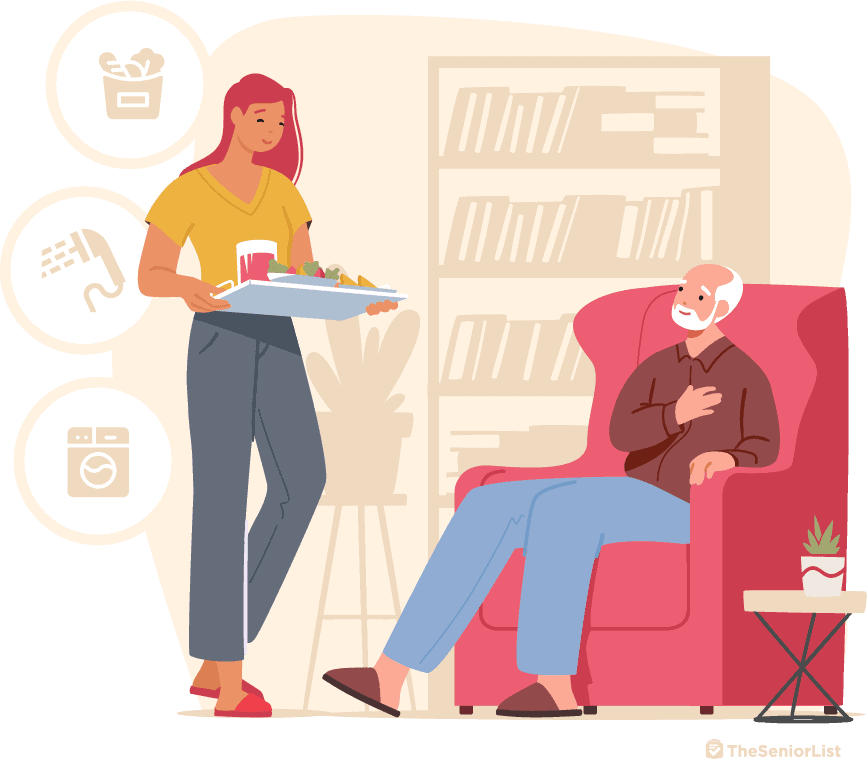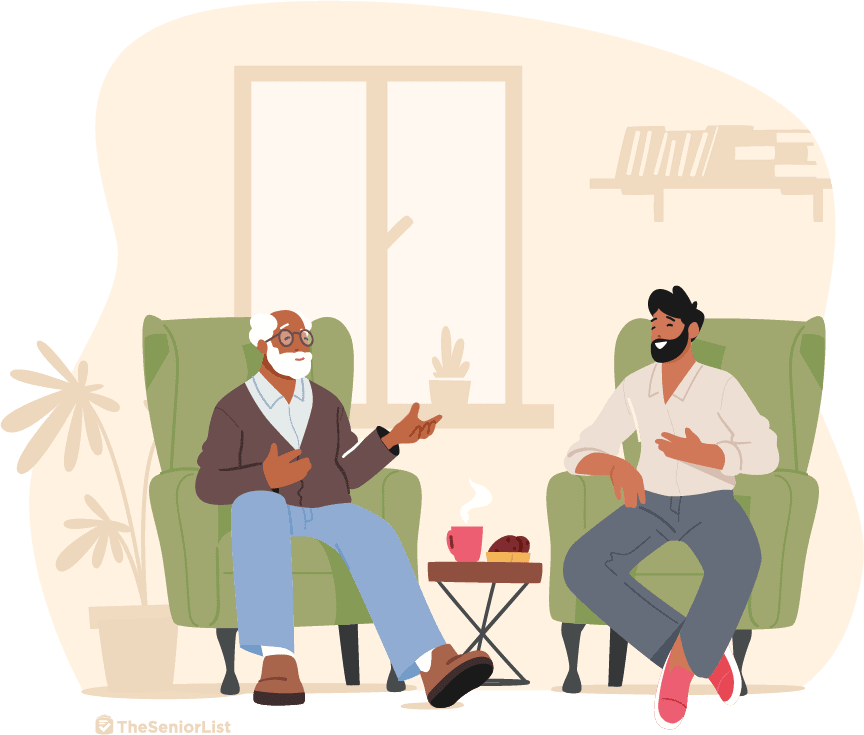How to Become a Caregiver: Paid, Volunteer, and Everything In Between
When considering taking on a caregiver role, the first question you should ask yourself is, What does it entail? The answer isn’t so cut and dry.
There are different types of caregivers, each with its level of assistance and duties. Some caregivers, such as certified nursing assistants (CNA) and home health aides (HHA), require a license or certification. Some caregivers are community volunteers, and others are private hires who work for third-party agencies or are independent contractors.
If you become a caregiver for a family member, you would be considered a family caregiver. As an occupational therapist, I have collaborated with all types of caregivers, and I greatly respect their work.
What Does a Caregiver Do?

Caregiving services vary greatly depending on the level and type of assistance a person needs. Some services caregivers can provide include:
- Help with self-care tasks, such as dressing, using a toilet, and bathing
- Home-management tasks, light housekeeping, and meal preparation
- Managing appointments and scheduling activities
- Community assistance, such as grocery shopping, picking up prescription medication, and driving a loved one to meet a friend
- Wound care, diabetes management, and medication management
- Providing companionship or respite care
Caregivers’ duties vary, but all are important. Each person’s needs are unique and vital to their ability to thrive in a home environment.
Let’s take a look at the types of caregivers and how they differ.
Volunteer Caregivers
This is a volunteer position, which means the caregiver will not be paid. Volunteers can be younger adults interested in the medical field, people who have retired and want to give back to their community, or even neighbors.
These volunteers do not provide medical assistance of any kind, nor do they hold an active license. They can provide respite care for the family, companionship, and supervision, or run errands and complete tasks such as laundry and light housekeeping. A volunteer caregiver’s duties may be limited, but the relief they can provide a person and their family can be a big help.
In my job as an occupational therapy assistant, I recently had a home health patient whose mobility was very limited due to lower-body weakness and balance issues. His wife normally assisted him with self-care, provided meals, and kept up their house. When she suddenly ended up in the hospital, my patient’s situation became dire since they had no family to help out.
Luckily, we were able to contact a friendly neighbor who agreed to check in once a day and assist with dressing, grooming, laundry, and meal prep until more permanent help could be secured. This is a perfect example of a volunteer caregiver.
Family Caregivers
Family caregivers care for their loved one at home, and they are typically related to the person they are caring for. This category can include close friends, but it typically is a spouse or a relative such as a parent or a child. Family caregivers offer varying levels of assistance, from help with self-care to providing rides to appointments.
Family caregivers may even assist with things such as diabetes management and wound care when they’re trained and approved by medical staff to do so. Outside hires such as HHAs or even CNAs would not be able to complete these tasks because they are medical and outside of their scope of practice. This is a benefit of being related to the person you are caring for.
Family caregivers can live with the person they are caring for or do daily check-ins and plan tasks on a daily schedule.
Pro Tip: If you’re looking to become a family caregiver, read my guide: How to Get Paid to Be a Caregiver.
Nonmedical Caregivers
Nonmedical caregivers can provide similar assistance to family caregivers as long as it is not medical in nature. The difference, however, is these individuals typically work for an agency or are independent contractors hired by the family. They do not need to be licensed for the type of assistance they provide, but they may have acquired some caregiver training.
Nonmedical caregivers work on set days for a specific amount of time. Many private nonmedical caregivers split their time. For instance, when I assist a family with discharge planning for their loved one — depending on the patient’s safety level and assistance needs — I may suggest the family hire a caregiver for two hours in the morning and two hours in the evening. That way, they can help get the person ready for the day, prep lunch and maybe start a load of laundry. When they return, they can help with dinner and the nighttime routine, and get the patient safely into bed.
Skilled Caregivers
Skilled caregivers will usually have an HHA certification or be licensed as a CNA, which can be beneficial since they will be professionally trained in bathing, grooming, toileting, transfers, and other skills. If your loved one requires more than minimal assistance, hiring a skilled caregiver may be in your best interest.
One thing to be aware of, however, is that CNAs and HHAs usually are not permitted to administer medication or perform more invasive procedures such as pricking a finger for blood sugar testing. A licensed practical nurse (LPN) or registered nurse (RN) typically will be required to administer medication, conduct wound-care procedures, and other tasks of that nature.
How to Become a Volunteer Caregiver
If you are interested in becoming a volunteer caregiver, there are a few ways to get started. Perhaps the easiest way is to offer assistance to a relative or neighbor in need. You can begin with simple assistance, such as providing companionship (chatting or playing games) or light household tasks such as laundry or tidying up for a few hours a day.
You can also contact local hospices in your area to ask about volunteering. Either visit their websites for more information about specific volunteer programs or call and ask to speak to the volunteer coordinator.
There are also websites, such as VolunteerMatch, that post volunteer opportunities that can be searched by location and category. Be aware that you will have restrictions when volunteering as a caregiver. In some states, caregiver training is required even for volunteers, and the scope of responsibility can vary.
In most states, volunteers are not permitted to assist with self-care such as bathing and toileting, administer medications, or give out medical or legal advice. Check your state’s requirements for volunteering before getting started.
How to Become a Certified Caregiver
If you’re considering a more serious position as a caregiver, I highly recommend looking into caregiver certification programs. When you are certified, your scope of practice will widen — as will your responsibilities.
As a certified caregiver, you will be trained in various caregiving topics, such as proper transfer techniques, activities of daily living, and home safety. Why is this important? If you are looking to break into caregiving as a career, then obtaining certification is necessary not only to gain proper training in the field, but also to reassure prospective clients of your professionalism and knowledge.
There are different levels of caregiver certification, including specialized training for conditions such as dementia and certifications for working in hospice or palliative care. As an occupational therapy assistant, I’ve often worked alongside people with basic caregiver certifications, certified CNAs, and HHAs. These caregivers can work in some or all of the following settings: nursing homes, assisted living facilities, home health, and even hospitals if they’re hired privately by a family.
Below I’ve broken down some of the differences between each, and how to go about obtaining each certification.
Basic Caregiver Certification
With this type of training, you will learn the basics of what every caregiver should know before embarking on their caregiving career. The course content can include disease and infection control, nutrition, effective communication, and even recreation and social aspects of caregiving.
It’s nonmedical caregiver training, and it provides the basis of knowledge for this type of work. There are several online options for training courses, such as the American Caregiver Association. Private caregivers with this certification can be hired by a family to provide care for their loved one, or you can obtain this certification when beginning your journey as a caregiver for someone in your own family.
Home Health Aide
Community colleges often offer courses for certification as a home health aide, but online courses are becoming more popular. It is important, however, to check with your state’s requirements before signing up.
Like basic caregiver certification, you will be required to complete a set amount of hours. This certification, however, will also require time in a clinical setting to complete your coursework. HHAs provide nonmedical care, including help with bathing, following a prescribed home exercise program, and light housework.
HHAs are under the direct supervision of a medical professional such as an RN or LPN. These are paid positions, and rates can vary depending on the setting you are working in.
To learn more about this type of caregiver, read my guide: What Is a Home Health Aide?
Certified Nursing Assistant
To become a CNA, you can look into classes at your local university or community college, or try online options such as CNAClasses.org. You can even register for classes with the Red Cross. If you complete the coursework and pass your state licensing board, you will be qualified to work in hospitals, nursing homes, or home health, and you will be able to earn more hourly than with the other certifications. CNAs work under the supervision of an RN or LPN.
Exact requirements vary by state, so it is important to check with your state before you begin any certification coursework.
How to Become a Caregiver for a Family Member
If you are interested in becoming a caregiver for a family member, the first question you should ask yourself is, What type of assistance — and how much — will my loved one require? You may be able to step into this role somewhat seamlessly if your family member needs minimal assistance, such as running errands, rides to appointments, and light housework.
Once the requirements become more involved, however, it may be prudent to obtain a certification to properly prepare and educate yourself for the task at hand. Once you’ve decided on this path, the steps to becoming a family caregiver are fairly straightforward.
- If you determine professional training is needed, then decide the level of care needed and research your state’s requirements for obtaining caregiver certification.
- Speak with your loved one regarding their needs, and determine set days and hours you will work to maintain healthy boundaries.
- Discuss duties and responsibilities, and write out the requirements. I have worked with many family caregivers, and I recommend this step. Outlining what your duties and responsibilities will be before you start will help you avoid awkward misunderstandings down the road. Keep in mind that your loved one’s needs — and your duties — will likely change as they age.
- Determine whether your loved one will pay you for your time, and, if so, iron out hourly or monthly compensation beforehand.
Getting Paid to Be a Caregiver
Your options may be limited for getting compensated as a family caregiver. There are avenues you can take to get paid, but it can be a somewhat involved process.
When I worked in the skilled nursing facility setting, I was deeply involved in discharge planning with all my patients and their families, assisting them in setting up the home and ensuring proper supervision. Unfortunately, the majority of insurance companies do not cover long-term caregiving.
Medicare (and most insurance companies that follow Medicare guidelines) will cover in-home caregiving only if it’s medically necessary while recovering from a recent hospital stay due to injury or surgery. Hiring private caregivers can be extremely costly if your loved one needs 24-hour — or even eight-hour — supervision. Many family members opt to step into this position instead, which means reducing hours at work or leaving a job entirely in order to provide quality care for their loved one. This can lead to great financial strain.
So, what can be done? There are a few options to be compensated as a family caregiver.
- If your loved one qualifies for Medicaid: Payment may be possible through the Self-Directed Personal Assistance Services State Plan Option, which basically allows your loved one to direct where their funds are used based on the budget they are allotted. That includes using some of the funds for caregiver compensation.
- If your loved one is a veteran: If your loved one is a military veteran under the care of a VA doctor, you may qualify for a stipend as the designated family caregiver. Your loved one will need to be evaluated by their Patient Aligned Care Team for eligibility.
- If your loved one has long-term-care insurance: Some long-term-care insurance policies will pay family caregivers for providing in-home care, but your loved one will have to already have the insurance in place before the need arises.
- Direct payment from your loved one: This option may not be viable for everyone, but it’s possible in many situations. Typically, your loved one will plan for care in their golden years. The alternative to home caregiving is placement in an assisted living facility or skilled nursing home. Both options are extremely costly, so some families are more than happy to use some of their savings to pay a family member instead.
Pro Tip: To learn more about qualifications, read my guide: Which States Pay Family Caregivers?
Why Become a Caregiver?
Providing any type of service to another human being can be satisfying, but the work you will do as a caregiver is truly something special. The impact your care will have on another person — whether it’s someone you’ve just met or a beloved family member — is immeasurable.
Whether you’re a family caregiver or you’ve decided to make this a career, the quality time and assistance you give this person will not only enrich their lives, but yours as well.
If you’re looking to care for a loved one at home, we’ve compiled a comprehensive array of guides to help you along your journey.
Becoming a Caregiver Frequently Asked Questions
-
Do you need a degree to be a caregiver?
You do not need a degree to become a custodial or nonmedical caregiver, but participating in some kind of caregiver training or obtaining caregiver certification can be beneficial.
-
Do caregivers make good money?
Caregiving is definitely an option for a career. How much money you make will depend on the type of caregiving you do and the licensure or certification you hold. In some states, CNAs can make $20 or more per hour, while the going rate for home health aides is about $10 to $15 per hour in most areas.
-
What are the four types of caregivers?
There are different ways to break it down, but the main types of caregivers are volunteer caregivers (usually community members), family caregivers (usually adult children or spouses), nonmedical caregivers (hired custodial care), and skilled caregivers who hold one or more certifications.
-
How hard is it to be a caregiver?
Caregiving can be a very rewarding career or pastime, but, like most things, it can have its challenges. Signing up for caregiver training or even acquiring a caregiver certification can be helpful in learning and understanding the skills necessary to best care for a person in need.
-
How are ambulance services billed?
Ambulance services are billed after the trip. You will receive a notice of whether Medicare covered the trip in your online Medicare account or your next Medicare Summary Notice. If a certain ambulance company believes Medicare may not cover your trip, they are required to give you an Advance Beneficiary Notice of Noncoverage for the ambulance trip cost.

